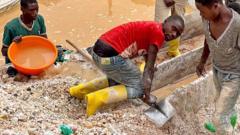In the heart of the Masisi Hills in North Kivu province, the Rubaya mine stands as an economic beacon amid turmoil. Recently, M23 rebels provided the BBC access to this pivotal site, where more than 10,000 miners toil daily extracting coltan ore, a critical component in the production of mobile phones and other electronic devices.
Miners labor tirelessly on a landscape dotted with gaping pits and labyrinthine tunnels, their determination evident as they hoist heavy sacks of ore with shovels and their bare hands. "We usually have more than 10,000 or more people working here daily," shared Patrice Musafiri, the mine supervisor. Navigating this treacherous terrain requires skill and warmth, as temperatures soar and dangerous gas accumulates—yet for many, mining is a lifeline, economically and socially. Miner Peter Osiasi, who expressed gratitude for the opportunities mining has provided, noted that he has been able to save money for a dowry and support his family.
The Rubaya mine is strategically located 60 kilometers from Goma, capturing 15% of the world’s coltan supply and half of the DR Congo's total reserves, making it an attractive site for global investment. While the region is fraught with conflict involving various armed groups, including the M23 rebels and ethnic militia, the mine remains operational under the enforcement of a ceasefire agreement recently signed in Washington, which aims to address decades of instability.
Despite the precarious security situation, Mr. Musafiri claims that improvements have been made within the mining sector. "We have already solved so many issues," he asserted, highlighting the establishment of a mining department that prioritizes worker safety and conflict resolution. Women are also seen at the mine, vending food and water to support the miners, indicating a broader economic activity surrounding the site.
However, miners like Osiasi lament the low wages, striving for better compensation as they work under less-than-ideal conditions. The mine’s lucrative nature has, in the past, attracted significant illicit revenue for armed groups, leading to ongoing complexities in governance and investment. Analysts suggest that American interests in the region’s minerals could usher in new investments—provided they prioritize community development, such as infrastructure and education.
Yet, with the M23 holding substantial power, questions remain about how potential investors can engage with local systems ruled by rebels. Meanwhile, humanitarian needs persist in surrounding communities, emphasizing the urgency for a resolution to ongoing violence and economic disparities.
As tensions remain, the miners' hope is palpable: “My appeal to fellow young men and our leaders is to keep and maintain peace in our area,” Osiasi stated. The Rubaya mine represents not just a resource for modern technology, but a complex intersection of hope, resilience, and the quest for stability amid the fragility of human life.






















